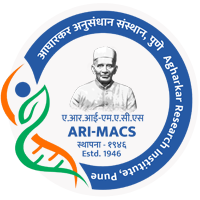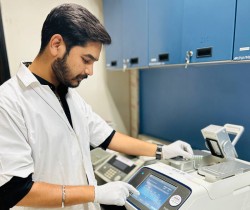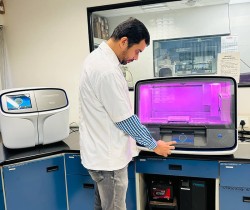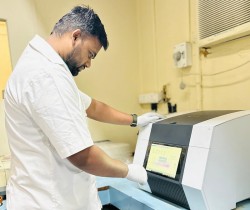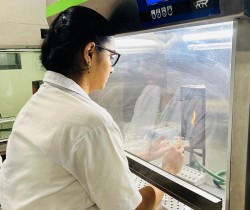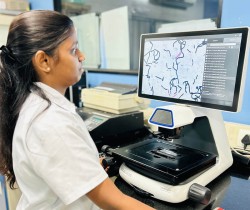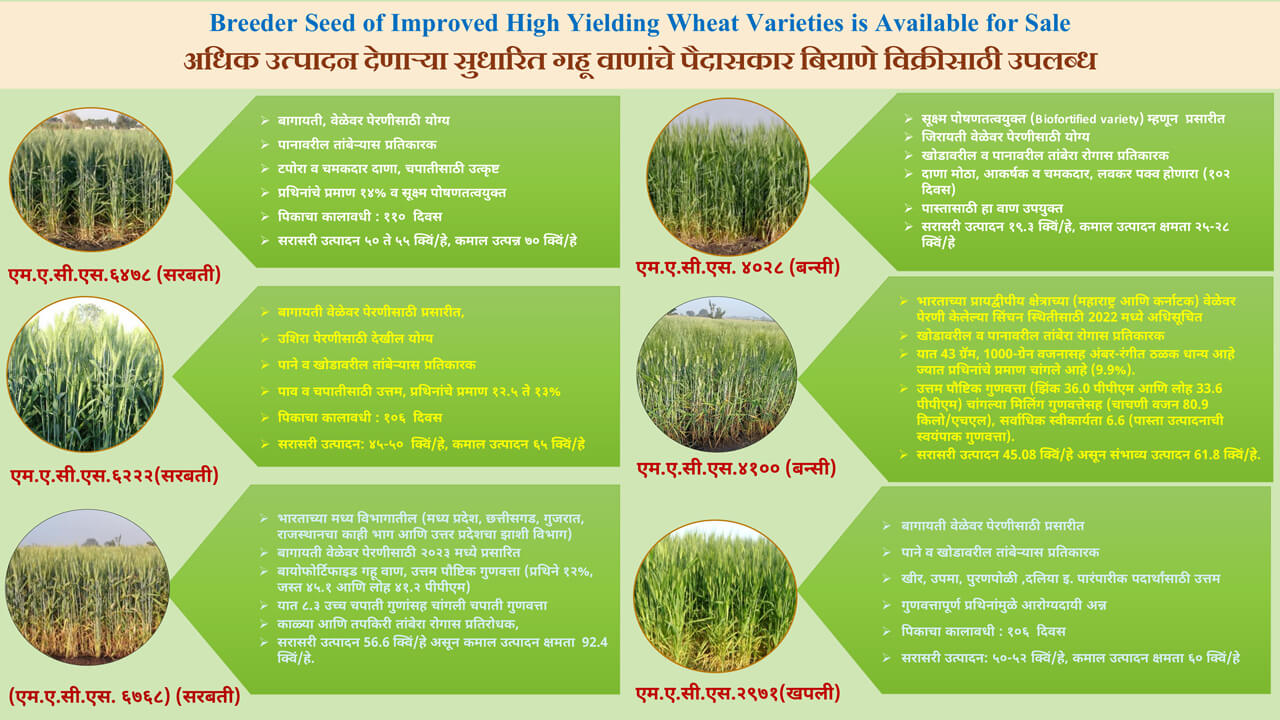
Google Scholar / Social Media
Name : Dr. Prashant Dhakephalkar
Designation : Director
Brief Background :
Dr. Prashant Dhakephalkar is a distinguished scientist and currently serves as the Director of Agharkar Research Institute (ARI). With a strong educational background and extensive scientific experience, he has made significant contributions to the field of microbiology and environmental research. His scientific journey began with his early academic achievements, culminating in a Ph.D. in Microbiology. In 1998 , he joined University of Virginia, Charlottesville, USA as a Postdoctoral researcher. He has over 30 years of experience in the field of microbiology and environmental research. His research focuses on investigating the microbial diversity associated with extreme, pristine, and other unique habitats for taxonomic novelty and biotechnological potential. Furthermore, his expertise in microbial cultures and consortiums has led to the development of cutting-edge technologies in the fields of bioenergy, petroleum biotechnology, bioremediation, and the production of valuable enzymes and biomolecules. He is widely recognized for his expertise in the field and has mentored 15 Ph.D. and several M.Sc. students. With a remarkable track record, he has authored over 98 papers in esteemed journals, solidifying his reputation as a prolific researcher in the field. He has also collaborated with several industrial partners such as ONGC, HTBL, KPIT, etc. to develop innovative technologies that address pressing environmental and energy challenges.
Dr. Prashant Dhakephalkar’s dedication to advancing scientific knowledge, coupled with his practical contributions through industrial collaborations, has established him as a leading figure in the field of microbiology and environmental research. Under his directorship, Agharkar Research Institute continues to thrive as a centre of excellence, fostering cutting-edge research and technological innovations.
Contact Details :
+91-20-25325096 (office) , Fax : +91-20-25651542
- B.Sc. Microbiology, SPPU
- M.Sc. Microbiology, SPPU
- Ph.D. Microbiology, SPPU
Technologies developed/ transferred with industrial sponsorship:
- Bio-scavenger: a microbial formulation that facilitates rapid degradation of human excreta, and also inhibits associated enteropathogens and malodor (sponsored by Vikalpa Technologies, Pune).
- ┬ĀPetroleum Biotechnology
- Microbial Enhanced Oil Recovery from high temperature (>90 ┬░C) depleting oil reservoirs (sponsored by IRS-ONGC, Ahmedabad)
- Bacteriophage mediated biocontrol of sulphate reducing bacteria and souring of oil wells (sponsored by ONGC Energy Centre, Delhi)
- Treatment of produced water to make it suitable for reinjection in oil wells (sponsored by IRS-ONGC, Ahmedabad)
- Bioremediation of terrestrial oil spills (sponsored by IRS-ONGC, Ahmedabad)
- ┬ĀBioenergy
- Biomethanation of rice straw without thermochemical pretreatment (Sponsored by DSM, India)
- Biomethanation of lignite, the low-grade coal (sponsored by sponsored by ONGC Energy Centre, Delhi)
- Biohydrogen production from agricultural or industrial waste (KPIT Technologies Ltd.)
- ┬ĀEnvironment friendly and energy efficient Microbial processes for the production industrially valuable products
- Microbial process for the production of optically pure amino acids (sponsored by Sci Molecules India Pvt. Ltd.)
- Probiotics as oral adjuncts for improved health and productivity of poultry (Sponsored by Hi Tech BioLaboratories, Pune)
- Value addition of commercial probiotics through characterization of health promoting and disease preventing properties of probiotics (sponsored by HiTech Bio Sciences India Ltd.)
Publications:
- Lanjekar, V. B., Hivarkar, S. S., Vasudevan, G., Joshi, A., Dhakephalkar, P. K., & Dagar, S. S. (2023). Actinomyces ruminis sp. nov., an obligately anaerobic bacterium isolated from the rumen of cattle. Archives of Microbiology, 205(1), 9.
- Sengupta, K., Hivarkar, S. S., Palevich, N., Chaudhary, P. P., Dhakephalkar, P. K., & Dagar, S. S. (2022). Genomic architecture of three newly isolated unclassified Butyrivibrio species elucidate their potential role in the rumen ecosystem. Genomics, 114(2), 110281.
- Avchar, R., Lanjekar, V., Dhakephalkar, P. K., Dagar, S. S., & Baghela, A. (2022). Compost as an untapped niche for thermotolerant yeasts capable of highŌĆÉtemperature ethanol production. Letters in Applied Microbiology, 74(1), 109-121.
- Kapse, N. G., Paliwal, V., Dagar, S. S., Rana, D. P., & Dhakephalkar, P. K. (2022). Genomics and simulated laboratory studies reveal Thermococcus sp. 101C5 as a novel hyperthermophilic archaeon possessing a specialized metabolic arsenal for enhanced oil recovery. Antonie van Leeuwenhoek, 1-13.
- Mehta, P., Deshmukh, K., Dagar, S. S., Dhakephalkar, P. K., & Lanjekar, V. B. (2021). Genome sequencing and analysis of a psychrotrophic methanogen Methanosarcina sp. nov. MSH10X1 cultured from methane hydrate deposits of Krishna Godavari Basin of India. Marine Genomics, 59, 100864.
- Avchar, R., Lanjekar, V., Kshirsagar, P., Dhakephalkar, P. K., Dagar, S. S., & Baghela, A. (2021). Buffalo rumen harbours diverse thermotolerant yeasts capable of producing second-generation bioethanol from lignocellulosic biomass. Renewable Energy, 173, 795-807.
- Singh, P., Kapse, N., Gowdaman, V., Tsuji, M., Singh, S. M., & Dhakephalkar, P. K. (2021). Comparative Genomic Analysis of Arctic Permafrost Bacterium Nesterenkonia sp. PF2B19 to Gain Insights into Its Cold Adaptation Tactic and Diverse Biotechnological Potential. Sustainability, 13(8), 4590.
- Kanekar, P. P., Kulkarni, S. O., Dhakephalkar, P. K., Saxena, N., & Pathan, H. M. (2021). Bacteriorhodopsin producing halophilic archaea isolated from solar salt pan saline environment for conversion of light energy into electrical energy. ES Energy & Environment, 13, 57-64.
- Devi, A. B., Rahigude, A. B., Parab, P. B., Engineer, A. S., Dhakephalkar, P. K., & Apte, K. G. (2021). A study to evaluate the hepatoprotective activity of prebiotics, probiotics, and synbiotic in CCl4 induced hepatotoxicity in rats. Journal of Applied Pharmaceutical Science, 11(3), 141-153.
- Nagkirti, P. D., Engineer, A. S., & Dhakephalkar, P. K. (2021). Xylanimonas oleitrophica sp. nov., a novel petroleum hydrocarbon degrading bacterium isolated from an Indian oil reservoir. Antonie van Leeuwenhoek, 114, 129-136.
- Tiwari, S., Avchar, R., Arora, R., Lanjekar, V., Dhakephalkar, P. K., Dagar, S. S., & Baghela, A. (2020). Xylanolytic and ethanologenic potential of gut associated yeasts from different species of termites from India. Mycobiology, 48(6), 501-511.
- Shetty, D., Joshi, A., Dagar, S. S., Kshirsagar, P., &Dhakephalkar, P. K. (2020). Bioaugmentation of anaerobic fungus Orpinomycesjoyonii boosts sustainable biomethanation of rice straw without pretreatment. Biomass and Bioenergy, 138, 105546.
- Hanafy, R.A., Lanjekar, V.B., Dhakephalkar, P.K., Callaghan, T.M., Dagar, S.S., Griffith, G.W., Elshahed M.S., Youssef, N.H. (2020): Seven new Neocallimastigomycota genera from wild, zoo-housed, and domesticated herbivores greatly expand the taxonomic diversity of the phylum, Mycologia, DOI: 10.1080/00275514.2019.1696619
- Engineer, A.S., Yadav, K.K., R. Kshirsagar, P.R., Dhakephalkar, P.K. (2020) A novel, enantioselective, thermostable recombinant hydantoinase to aid the synthesis of industrially valuable non-proteinogenic amino acids. Enzyme and Microbial Technology. 138: https://doi.org/10.1016/j.enzmictec.2020.109554
- Arora, P., Kshirsagar, P.R., Rana, D.P., Dhakephalkar, P.K. (2019) Hyperthermophilic Clostridium sp. N-4 produced a glycoprotein biosurfactant that enhanced recovery of residual oil at 96┬░ C in lab studies. Colloids and Surfaces B: Biointerfaces. https://doi.org/10.1016/j.colsurfb.2019.110372
- Tapadia-Maheshwari, S.N., Pore, S.D., Engineer, A.S., Shetty, D.S., Dagar, S.S., Dhakephalkar, P.K. (2019) Illustration of the microbial community selected by optimized process and nutritional parameters resulting in enhanced biomethanation of rice straw without thermo-chemical pretreatment. Bioresource Technology. 289: 121639. https://doi.org/10.1016/j.biortech.2019.121639┬Ā
- Rahalkar, M. C., Khatri, K., Pandit, P. S., &Dhakephalkar, P. K. (2019). A putative novel Methylobacter member (KRF1) from the globally important Methylobacter clade 2: cultivation and salient draft genome features. Antonie Van Leeuwenhoek, 112(9), 1399-1408.
- Pore, S.D., Engineer, A.S., Dagar, S.S., Dhakephalkar, P.K. (2019) Meta-omics based analyses of microbiome involved in biomethanation of rice straw in a thermophilic anaerobic bioreactor under optimized conditions. Bioresour Technol. 279: 25-33. IF 5.807
- Joshi, A., Lanjekar, V. B., Dhakephalkar, P. K., Callaghan, T. M., Griffith, G. W., Dagar, S. S. (2018). Liebetanzomycespolymorphus gen. et sp. nov., a new anaerobic fungus (Neocallimastigomycota) isolated from the rumen of a goat. MycoKeys. 40: 89 ŌĆō 110. IF 3.269
- Joshi, A., Lanjekar, V., Dhakephalkar, P. K., Dagar, S. S. (2018). Cultivation of multiple genera of hydrogenotrophic methanogens from different environmental niches. Anaerobe. 50: 64-68. IF 2.742
- Kapse, N.G., Engineer, A.S., Gowdaman, V., Wagh, S., Dhakephalkar, P.K. (2018). Functional annotation of the genome unravels probiotic potential of Bacillus coagulans HS243. Genomics. https://doi.org/10.1016/j.ygeno.2018.05.022. IF 2.910
- Patwardhan, R. B., Dhakephalkar, P. K., Chopade, B. A., Dhavale, D. D., Bhonde, R. R. (2018). Purification and characterization of an active principle, lawsone, responsible for the plasmid curing activity of Plumbago zeylanica root extracts. Front Microbiol. 9: 1-10. IF 4.019
- Rahalkar, M.C., Patil, S., Dhakephalkar, P.K., Bahulikar, R.A. (2018). Cultivated methanotrophs associated with rhizospheres of traditional rice landraces from Western India belong to Methylocaldum and Methylocystis. 3 Biotech. 8: 281. IF 1.497
- Singh, T., Kshirsagar, P. R., Das, A., Yadav, K., Mallik, S., MascarenhasŌĆÉPereira, M. B. L., Thomas, T.A., Shivaramu M. S., LokaBharati, P.A., Khadge, N.H., Nath, B.N., Dhakephalkar, P. K., Iyer, S. D., Ray, D., Valsangkar, A.B., Garg, A., Prakash Babu, C., Waghole, R.J., Waghmare, S. S., Rajwade, J.M., Paknikar, K.M. (2018). Implications of microbial thiosulfate utilization in red clay sediments of the Central Indian BasinŌĆÉThe┬Ā Martian Analogy. Geochemistry, Geophysics, Geosystems.┬Ā ┬Ā https://doi.org/10.1029/2018GC007640. IF 2.98
- Joshi, A., Vasudevan, G., Engineer, A., Pore, S., Hivarkar, S. S., Lanjekar, V. B., Dhakephalkar, P. K., Dagar, S. S. (2018). Genomic Analysis of Actinomyces sp. Strain CtC72, a Novel Fibrolytic Anaerobic Bacterium Isolated from Cattle Rumen. Microbiol. Biotechnol. Lett. 46: 59ŌĆō67
- Das, A., Singh, T., LokaBharathi, P. A., Dhakephalkar, P. K., Mallik, S., Kshirsagar, P. R., & Kaur, P. (2017). Astrobiological implications of dim light phototrophy in deep-sea red clays. Life Sci. Space Res, 12, 39-50.
- Joshi, V., Shah, N., Wakte, P., Dhakephalkar, P., Dhakephalkar, A., Khobragade, R., Naphade, B., Shaikh, S., Deshmukh, A., Adhapure, N. (2017). Comparative bioleaching of metals from pulverized and non-pulverized PCBs of cell phone charger: advantages of non-pulverized PCBs. Environ Sci Pollut Res. 24: 28277-28286. IF 2.8
- Kanekar, P. P., Kulkarni, S. O., Dhakephalkar, P. K., Kulkarni, K. G., Saxena, N. (2017). Isolation of a halophilic, bacteriorhodopsin-producing archaeon, Haloferaxlarsenii RG3D.1 from the rocky beach of Malvan, West Coast of India. Geomicrobiol J. 34: 242-248. IF 1.433
- Shetty, D. J., Kshirsagar, P., Tapadia-Maheshwari, S., Lanjekar, V., Singh, S. K., Dhakephalkar, P. K. (2017). Alkali pretreatment at ambient temperature: A promising method to enhance biomethanation of rice straw. Bioresour Technol. 226: 80-88. IF 5.807
- Parmar, K. M., Gaikwad, S. L., Dhakephalkar, P. K., Kothari, R., Singh, R. P. (2017). Intriguing interaction of bacteriophage-host association: an understanding in the era of omics. Front Microbiol. 8: 559.
- Singh, K., Gedam, P. S., Raut, A. N., Dhamole, P. B., Dhakephalkar, P. K., Ranade, D. R. (2017). Enhanced n-butanol production by Clostridium beijerinckii MCMB 581 in presence of selected surfactant. 3 Biotech. 7: 161. IF 1.497
- Dangi, R., Oulkar, D., Dhakephalkar, P., Singh, S. K., Banerjee, K., Naik, D., & Dangi, R. (2016). Antimicrobial Activity of Some Trigonella Species. Int. J. Phytomedicine, 8, 80-94.
- Pandit, P.S., Ranade, D.R., Dhakephalkar, P.K., Rahalkar, M.C. (2016). A pmoA-based study reveals dominance of yet uncultured Type I methanotrophs in rhizospheres of an organically fertilized rice field in India. 3 Biotech. 6: 1-6. IF 1.497
- Antony, R., Sanyal, A., Kapse, N., Dhakephalkar, P. K., Thamban, M., Nair, S. (2016). Microbial communities associated with Antarctic snow pack and their biogeochemical implications. Microbiol Res. 192: 192-202. IF 2.777
- Kamalaskar, L., Kapse, N., Pore, S., Dhakephalkar, A. P., Ranade, D. R., Dhakephalkar, P. K. (2016). Genome sequence and gene expression studies reveal novel hydrogenases mediated hydrogen production by Clostridium biohydrogenum sp. nov., MCM B-509T. Int J Hydrogen Energ. 41: 11990-11999. IF 4.229
- Rahalkar, M. C., Pandit, P. S., Dhakephalkar, P. K., Pore, S., Arora, P., Kapse, N. (2016). Genome characteristics of a novel type I methanotroph (Sn10-6) isolated from a flooded Indian rice field. Microb Ecol. 71: 519-523. IF 3.614
- Pandit, P. S., Rahalkar, M. C., Dhakephalkar, P. K., Ranade, D. R., Pore, S., Arora, P., Kapse, N. (2016). Deciphering community structure of methanotrophs dwelling in rice rhizospheres of an Indian rice field using cultivation and cultivation-independent approaches. Microb Ecol. 71: 634-644. IF 3.614
- Pore, S. D., Shetty, D., Arora, P., Maheshwari, S., Dhakephalkar, P. K. (2016). Metagenome changes in the biogas producing community during anaerobic digestion of rice straw. Bioresour Technol. 213: 50-53. IF 5.807
- Saxena, N., Pore, S., Arora, P., Kapse, N., Engineer, A., Ranade, D. R., Dhakephalkar, P. K. (2015). Cultivable bacterial flora of Indian oil reservoir: isolation, identification and characterization of the biotechnological potential. Biologia. 70: 1-10. IF 0.696
- Rahalkar, M. C., Pore, S., Arora, P., Pandit, P., Kapse, N., Bahulikar, R., Schink, B., Dhakephalkar, P. K. (2015). Draft genome of Elsteralitoralis, a freshwater epilithic biofilm associated bacterium from littoral zone of Lake Constance. Mar Genom. 24: 223-224. IF 1.937
- Honkalas, V. S., Dabir, A. P., Arora, P., Ranade, D. R., Dhakephalkar, P. K. (2015). Draft genome sequence of Clostridium sulfidigenes 113A isolated from sub-seafloor sediments associated with methane hydrate deposits. Mar Genom. 22: 23-24. IF 1.937
- Honkalas, V. S., Dabir, A. P., Arora, P., Ranade, D. R., Dhakephalkar, P. K. (2015). Draft genome sequence of Clostridium celerecrescens 152B isolated from sub-seafloor methane hydrate deposits. Mar Genom. 21: 23-24. IF 1.937
- Singh, P., Kapse, N., Arora, P., Singh, S. M., Dhakephalkar, P. K. (2015). Draft genome of Cryobacterium sp. MLB-32, an obligate psychrophile from glacier cryoconite holes of high Arctic. Mar Genom. 21: 25-26. IF 1.937
- Patwardhan, R. B., Dhakephalkar, P. K., & Chopade, B. A. (2015). Antibacterial and plasmid curing activities of root extracts of Plumbago zeylanica. Int. J. Herb. Med, 2(1), 13-25.
- Palande, V., Meora, R., Sonavale, R. M., Makashir, M., Modak, M. S., Kapse, N., & Kunchiraman, B. N. (2015). Inhibition of pathogenic strains of Candida albicans and non-albicans by Bacillus species isolated from traditional Indian fermented food preparations. Int. J. Curr. Microbiol. App. Sci, 4(3), 691-699.
- Adhapure, N. N., Dhakephalkar, P. K., Dhakephalkar, A. P., Tembhurkar, V. R., Rajgure, A. V., & Deshmukh, A. M. (2014). Use of large pieces of printed circuit boards for bioleaching to avoid ŌĆśprecipitate contamination problemŌĆÖand to simplify overall metal recovery. MethodsX, 1, 181-186.
- Kalmath, B. S., Prabhuraj, A., Dhakephalkar, P. K., Supreet, H., & Giraddi, R. S. (2014). Characterization of Lysinibacillus sphaericus C3-41 strain isolated from northern Karnataka, India that is toxic to mosquito larvae. Journal of Biological Control, 28(1), 24-30.
- Dabir, A., Honkalas, V., Arora, P., Pore, S., Ranade, D. R., Dhakephalkar, P. K. (2014). Draft genome sequence of Methanoculleus sp. MH98A, a novel methanogen isolated from sub-seafloor methane hydrate deposits in Krishna Godavari basin. Mar Genom. 18: 139-140. IF 1.937
- Arora, P., Ranade, D. R., Dhakephalkar, P. K. (2014). Development of a microbial process for the recovery of petroleum oil from depleted reservoirs at 91ŌĆō96 ┬░C. Bioresour Technol. 165: 274-278. IF 5.807
- Singh, P., Singh, S. M., Dhakephalkar, P. (2014). Diversity, cold active enzymes and adaptation strategies of bacteria inhabiting glacier cryoconite holes of High Arctic. Extremophiles. 18: 229-242. IF 2.00
- Polkade, A., Shede, P., Kanekar, P., Dhakephalkar, P., & Sarnaik, S. (2013). Designing and Evaluation of Skin Extract Agar for Isolation of Microflora from Raw Buffalo Hide. IIOAB Letters, 3(1).
- Engineer, A. S., Dhakephalkar, A. P., Gaikaiwari, R. P., Dhakephalkar, P. K. (2013). Process parameter optimization for hydantoinase-mediated synthesis of optically pure carbamoyl amino acids of industrial value using Pseudomonas aeruginosa resting cells. J Ind Microbiol Biot. 40: 1367-1372. IF 3.103
- Antony, R., Krishnan, K. P., Laluraj, C. M., Thamban, M., Dhakephalkar, P. K., Engineer, A. S., Shivaji, S. (2012). Diversity and physiology of culturable bacteria associated with a coastal Antarctic ice core. Microbiol Res. 167: 372-380. IF 2.777
- Purushe, S., Prakash, D., Nawani, N. N., Dhakephalkar, P., Kapadnis, B. (2012). Biocatalytic potential of an alkalophilic and thermophilic dextranase as a remedial measure for dextran removal during sugar manufacture. Bioresour Technol. 115: 2-7. IF 5.807
- Pour, N. K., Dusane, D. H., Dhakephalkar, P. K., Zamin, F. R., Zinjarde, S. S., Chopade, B. A. (2011). Biofilm formation by Acinetobacter baumannii strains isolated from urinary tract infection and urinary catheters. FEMS Immunol Med Mic. 62: 328-338. IF 2.554
- Rokhbakhsh-Zamin, F., Sachdev, D., Kazemi-Pour, N., Engineer, A., Pardesi, K. R., Zinjarde, S., Dhakephalkar, P.K., Chopade, B. A. (2011). Characterization of plant-growth-promoting traits of Acinetobacter species isolated from rhizosphere of Pennisetumglaucum. JMicrobiol Biotechnol., 21: 556-566. IF 1.65
- Satpute, M. G., Telang, N. V., Dhakephalkar, P. K., Niphadkar, K. B., Joshi, S. G. (2011). Isolation of Burkholderiacenocepacia J 2315 from non-cystic fibrosis pediatric patients in India. Am J Infect Control. 39: e21-e23. IF 1.929
- Kamalaskar, L. B., Dhakephalkar, P. K., Meher, K. K., Ranade, D. R. (2010). High biohydrogen yielding Clostridium sp. DMHC-10 isolated from sludge of distillery waste treatment plant. Int J Hydrogen Energ. 35: 10639-10644. IF 4.229
- Varsha, S., Sheetal, J., Latha, C., Vinay, K., Prashant, D., Supada, R., Shitole, M. G. (2010). Antibacterial &antiplasmid activities of Helicteresisora L. Indian J Med Res. 132: 94-99. IF 1.508
- Satpute, S. K., Banat, I. M., Dhakephalkar, P. K., Banpurkar, A. G., Chopade, B. A. (2010). Biosurfactants, bioemulsifiers and exopolysaccharides from marine microorganisms. Biotechnol Adv. 28: 436-450. IF 11.452
- Sachdev, D., Nema, P., Dhakephalkar, P., Zinjarde, S., Chopade, B. (2010). Assessment of 16S rRNA gene-based phylogenetic diversity and promising plant growth-promoting traits of Acinetobacter community from the rhizosphere of wheat. Microbiol Res. 165: 627-638. IF 2.777
- Satpute, S. K., Banpurkar, A. G., Dhakephalkar, P. K., Banat, I. M., Chopade, B. A. (2010). Methods for investigating biosurfactants and bioemulsifiers: a review. Crit Rev Biotechnol. 30: 127-144. IF 5.239
- Shede, P. N., Kanekar, P. P., Polkade, A. V., Sarnaik, S. S., Dhakephalkar, P. K., Chiplonkar, S. A., Nilegaonkar, S. S. (2009). Effect of microbial activities on stored raw buffalo hide. J Environ Biol. 30: 983-988. IF 0.727
- Pol, S. S., Dhakephalkar, P. K., Bharadwaj, R. S. (2009). Characterization of leptospires using V3 region of 16S rDNA by denaturing gradient gel electrophoresis: a case study. Indian J Med Microbi. 27: 354-257. IF 1.157
- Latha, C., Shriram, V. D., Jahagirdar, S. S., Dhakephalkar, P. K., Rojatkar, S. R. (2009). Antiplasmid activity of 1ŌĆ▓-acetoxychavicol acetate from Alpinia galanga against multi-drug resistant bacteria. J Ethnopharmacol. 123: 522-525. IF 3.115
- Deshmukh, N. S., Lapsiya, K. L., Savant, D. V., Chiplonkar, S. A., Yeole, T. Y., Dhakephalkar, P. K., Ranade, D. R. (2009). Upflow anaerobic filter for the degradation of adsorbable organic halides (AOX) from bleach composite wastewater of pulp and paper industry. Chemosphere. 75: 1179-1185. IF 4.427
- Shakibaie, M. R., Dhakephalker, P., Kapadnis, B. P., & An, B. (2009). Conjugational transfer and survival of plasmid encoding silver and antibiotic resistance genes of Acinetobacter baumannii BL54, E. coli K12 J53. 2 transconjugants and pseudomonas transformants in different soil microcosms. Afr. J. Microbiol. Res, 1(7), 079-084.
- Sachdev, D., Agarwal, V., Verma, P., Shouche, Y., Dhakephalkar, P., & Chopade, B. (2009). Assessment of microbial biota associated with rhizosphere of wheat (Triticum aestivum) during flowering stage and their plant growth promoting traits. Internet J Microbiol.
- Jahagirdar, S., Patwardhan, R., Dhakephalkar, P. K. (2008). Curing plasmid-mediated vancomycin resistance in Staphylococcus aureus using herbal naphthoquinones. J Hosp. Infect. 70: 289-291. IF 3.354
- Patwardhan, R. B., Dhakephalkar, P. K., Niphadkar, K. B., Chopade, B. A. (2008). A study on nosocomial pathogens in ICU with special reference to multiresistantAcinetobacter baumanniiharbouring multiple plasmids. Indian J Med Res. 128: 178-188. IF 1.508
- Satpute, S. K., Bhawsar, B. D., Dhakephalkar, P. K., Chopade, B. A. (2008) Assessment of different screening methods for selecting biosurfactant producing marine bacteria. Indian J Mar Sci. 37: 243-250. IF 0.316
- Shriram, V., Jahagirdar, S., Latha, C., Kumar, V., Puranik, V., Rojatkar, S., Dhakephalkar, P.K., Shitole, M. G. (2008). A potential plasmid-curing agent, 8-epidiosbulbin E acetate, from DioscoreabulbiferaL. against multidrug-resistant bacteria. Int J Antimicrob At. 32: 405-410. IF 4.253
- Shede, P. N., Kanekar, P. P., Polkade, A. V., Dhakephalkar, P. K., Sarnaik, S. S. (2008). Bacterial succession on raw buffalo hide and their degradative activities during ambient storage. Int BiodeterBiodegr. 62: 65-74. IF 3.562
- Sathe, S. J., Nawani, N. N., Dhakephalkar, P. K., Kapadnis, B. P. (2007). Antifungal lactic acid bacteria with potential to prolong shelfŌĆÉlife of fresh vegetables. J Appl Microbiol. 103: 2622-2628. IF 2.16
- Vaishampayan, P. A., Kanekar, P. P., Dhakephalkar, P. K. (2007). Isolation and characterization of Arthrobacter sp. strain MCM B-436, an atrazine-degrading bacterium, from rhizospheric soil. Int BiodeterBiodegr. 60: 273-278. IF 3.562
- Wani, R., Kodam, K. M., Gawai, K. R., Dhakephalkar, P. K. (2007). Chromate reduction by Burkholderiacepacia MCMB-821, isolated from the pristine habitat of alkaline crater lake. Appl Microbiol Biotechnol. 75: 627-632. IF 3.34
- Nilegaonkar, S. S., Zambare, V. P., Kanekar, P. P., Dhakephalkar, P. K., Sarnaik, S. S. (2007). Production and partial characterization of dehairing protease from Bacillus cereus MCM B-326. Bioresour Technol. 98: 1238-1245.IF 5.807
- Shakibaie, M.R., Dhakephalker, P.K., Kapadnis, B.P., Chopade, B.A. (2003) Silver resistance in Acinetobacter baumanniiBL54 occurs through binding to a Ag-Binding Protein. Iran. J. Biotechnol. 1:41-46. IF 0.338
- Bhadbhade, B. J., Dhakephalkar, P. K., Sarnaik, S. S., Kanekar, P. P. (2002). Plasmid-associated biodegradation of an organophosphorus pesticide, monocrotophos, by Pseudomonas mendocina. Biotechnol let. 24: 647-650. IF 1.846
- Deshpande, N. M., Dhakephalkar, P. K., Kanekar, P. P. (2001). PlasmidŌĆÉmediated dimethoate degradation in Pseudomonas aeruginosa MCMBŌĆÉ427. Lett Appl Microbiol. 33: 275-279. IF 1.471
- Deshmukh, U. S., Lewis, J. E., Gaskin, F., Dhakephalkar, P. K., Kannapell, C. C., Waters, S. T., Fu, S. M. (2000). Ro60 peptides induce antibodies to similar epitopes shared among lupus-related autoantigens. J Immunol. 164: 6655-6661. IF 4.539
- Deshmuck, U. S., Lewis, J. E., Dhakephalkar, P., Gaskin, F., & Fu, S. M. (1999). Immune responses to Ro60/ssa and its peptides in mice. Lack of tolerance and evidence for antibodies to crossreactive epitopes in Sle-related autoantigens. Scandinavian Journal of Immunology, 50(1), 105.┬Ā IF 2.314
- Shakibaie, M. R., Kapadnis, B. P., Dhakephalker, P., Chopade, B. A. (1999). Removal of silver from photographic wastewater effluent using Acinetobacter baumannii BL54.Can J Microbiol. 45: 995-1000. IF 1.234
- Salunkhe, P. B., Dhakephalkar, P. K., Paknikar, K. M. (1998). Bioremediation of hexavalent chromium in soil microcosms. Biotechnollett. 20: 749-751. IF┬Ā
- Bhide, J. V., Dhakephalkar, P. K., Paknikar, K. M. (1996). Microbiological process for the removal of Cr (VI) from chromate-bearing cooling tower effluent. Biotechnollett. 18: 667-672. IF 1.846
- Dhakephalkar, P. K., Bhide, J. V., Paknikar, K. M. (1996). Plasmid mediated chromate resistance and reduction in Pseudomonas mendocina MCM B-180. Biotechnollett. 18: 1119-1122. IF 1.846
- Dhakephalkar, P. K., Chopade, B. A. (1994). High levels of multiple metal resistance and its correlation to antibiotic resistance in environmental isolates of Acinetobacter. Biometals. 7: 67-74. IF 2.478
- Kunte, D. P., Dhakephalkar, P. K., Mukerjee, A., Patil, A., Kumbhar, A. S., Padhye, S. B., Chopade, B. A. (1993). Elimination of plasmid mediated antibiotic and metal resistance in Acinetobacter baumannii C11 by naturally occorring quinones and their metal complexes.┬Ā J InorgBiochem. 51: 387. IF 3.063
- Dhakephalkar, P. K., Kumbhar, A. S., Padhye, S. B., Chopade, B. A. (1993). Mechanism of plasmid encoded mercury volatilization in Acinetobacter junii ACN4. J InorgBiochem. 51: 388. IF 3.348
- Pore, S. D., Arora, P., & Dhakephalkar, P. K. (2014). Draft genome sequence of Geobacillus sp. strain FW23, isolated from a formation water sample. Genome Announc. 2(3).
- Kanekar, S. P., Saxena, N., Pore, S. D., Arora, P., Kanekar, P. P., & Dhakephalkar, P. K. (2015). Draft genome sequence of Halostagnicola sp. A56, an extremely halophilic archaeon isolated from the Andaman Islands. Genome Announc, 3(6).
- Srivastava, Pratibha., Wagh, R. S., Puranik, N. V., Puntambekar, H. M., Jahagirdar, S. J., & Dhakephalkar, P. K. (2015). In vitro plasmid curing activity of aqueous extract of Terminalia chebula fruit against plasmid of Bacillus subtilis and Shigella sonnei. Int J Pharma Pharmaceut Sci, 7(4), 298-301.
- Lanjekar, V. B., Deshpande, M. G., Padmanabhan, G., Dnyansagar, V. R., Ranade, D. R., & Dhakephalkar, P. K. (2016). Development of a Bioprocess to Reduce Pathogenic Load and Malodor of Human Night Soil. South Asian Journal of Experimental Biology, 5(6), 251-257.
- Kapse, N., Singh, P., Roy, U., Singh, S. M., & Dhakephalkar, P. K. (2017). Insights into the Psychrophilic and Sea Ice-Specific Lifestyle of Marinobacter sp. Strain AC-23: a Genomic Approach. Genome Announc, 5(15).
- Singh, P., Kapse, N., Roy, U., Singh, S. M., & Dhakephalkar, P. K. (2017). Draft genome sequence of permafrost bacterium Nesterenkonia sp. strain PF2B19, revealing a cold adaptation strategy and diverse biotechnological potential. Genome Announc, 5(15).
- Kapse, N. G., Engineer, A. S., Gowdaman, V., Wagh, S., & Dhakephalkar, P. K. (2018). Genome Profiling for Health Promoting and Disease Preventing Traits Unraveled Probiotic Potential of Bacillus clausii B106. Microbiology and Biotechnology Letters, 46(4), 334-345.
- Shakibaie, M. R., Dhakephalker, P. K., Kapadnis, B. P., Salajaghe, G. A., & Chopade, B. A. (1998). Plasmid mediated silver and antibiotic resistance in Acinetobacter baumannii BL54. Iran. J. Med. Sci, 23(1-2), 30-36.
Book Chapters:
- Dhakephalkar, P. K., Prakash, O., Lanjekar, V. B., Tukdeo, M. P., & Ranade, D. R. (2019). Methanogens for Human Welfare: More Boon Than Bane. In Microbial Diversity in Ecosystem Sustainability and Biotechnological Applications (pp. 565-591). Springer, Singapore.
- Nagkirti, P., Shaikh, A., Vasudevan, G., Paliwal, V., Dhakephalkar, P. (2017). Bioremediation of terrestrial oil spills: Feasibility Assessment, in: Purohit, H.J., et al (eds), Optimization and applicability of bioprocesses, Springer Nature Singapore Pte. Ltd, Singapore, pp. 141-173.
- Kanekar, P. P., Deshmukh, S.V., Kanekar, S. P., Dhakephalkar, P.K., Ranjekar, P. (2016). Exopolysaccharides of halophilic microorganisms: an overview. in: Thangadurai, D. & Sangeetha, J. (eds) Industrial Biotechnology ŌĆō Sustainable production and bioresource utilization, Apple Academic Press, pp 1-28.
- Honkalas, V., Dabir, A., Dhakephalkar, P. K. (2016). Life in the anoxic sub-seafloor environment: linking microbial metabolism and mega reserves of methane hydrate.┬Ā in: Hatti-Kaul, R., Mamo, G., Mattiasson, B. (eds) Anaerobes in Biotechnology. Advances in Biochemical Engineering/Biotechnology, Springer, Cham, pp. 235-262.
- Kanekar, P. P., Kanekar, S. P., Kelkar, A. S., Dhakephalkar, P. K. (2012). HalophilesŌĆōTaxonomy, diversity, physiology and applications. in:┬Ā Satyanarayan, T., Johri, B.N., Prakash, A (eds) Microorganisms in Environmental Management, Springer, Dordrecht. pp. 1-34.┬Ā
- Satpute, S. K., Bhuyan, S. S., Pardesi, K. R., Mujumdar, S. S., Dhakephalkar, P. K., Shete, A. M., Chopade, B. A. (2010). Molecular genetics of biosurfactant synthesis in microorganisms. in: Nathan, B., et al (eds) Biosurfactants, Springer, New York, NY, pp. 14-41.
- Maheshwari, S., Kshirsagar, P. and Dhakephalkar, P., 2019. Biomethanation of rice straw – Feasibility assessment. In Biogas Technology. New India Publishing Agency, New Delhi, India.
- Dhakephalkar, P.K. Ranade, D.R., (2005). Molecular analysis of microbial community to enhance performance of anaerobic digestors. in: Satyanarayana, T & Johri, B.N. (eds) Microbial Diversity: Current perspectives and potential applications. I.K. International Publishing House Pvt. Ltd. New Delhi. pp. 119-128.
- Engineer A. S & Dhakephalkar P. K. (2014) Data mining and Bioprospecting: In pursuit of more efficient enantioselective hydantoinases for the synthesis of optically pure amino acids. In (Eds) Neelu Nawani, Madhukar Khetmalas, Ashok Pandey, PN Razdan and KB Powar. Advances in Biotechnology and Allied areas, IK International. India. pp. 217-238
- Chopade, B. A., Patwardhan, R. B., Dhakephalkar, P. K. (1994). Acinetobacter infections in India: genetic and molecular biological studies and some approaches to the problem. in: Kumar, S., et al (eds) Tropical diseases: Molecular Biology and Control strategies. Publications and Information Directorate, New Delhi, pp. 704-717.
- Chopade, B.A, Patwardhan, R.B., Vaidya, V.C., Khairnar, S., Dhakephalkar, P.K., Padhye, S.B. (1994) Elimination of antibiotic and metal resistance plasmids in human pathogenic Acinetobacter species. in:┬Ā Kumar, S., et al (eds) Tropical diseases: Molecular biology and control strategies, Publications and Information Directorate, New Delhi, pp. 695-703.
Patents:
- Shete, S.D., Dhakephalkar,P. K., Kanekar,┬Ā P.P., Ranade, D.R. & Rao, J.U. Production of cerium sulfide pigment by a novel microbiological process using ┬Ā ┬Ā recombinant strain of E. coli. Indian Patent Number(s): 512/MUM/2013.
- Ranade, D.R., Kamalaskar, L., Lapsiya, K., Kshirsagar, P.R. & Dhakephalkar, P.K. A method for continuous generation of hydrogen by biodegradation of organic matter using Clostridium biohydrogenum MCM B-509 sp nov. Indian Patent Number(s): 412/MUM/2014.┬Ā
- Engineer, A.S., Dhakephalkar, P.K. & Gaikaiwari, R.P. Microbial Process for the production of optically pure unnatural carbamoyl amino acids. Indian Patent Number(s): 1384/MUM/2013.┬Ā
- Dhakephalkar, P.K.,Ranade, D.R.,Bateja, S.,Biswas, S.K.,Kukreti, V. & Rana, D.P. Process for Enhanced Recovery of Crude Oil from Oil-Wells at 91┬░C or Higher Temperatures Using Hyperthermophilic Indigenous or Injected Microorganisms / Consortia. Indian Patent Number(s): 751/MUM/2014.┬Ā
- Ranade, D. R., Dhakephalkar, P. K., Deshpande, M. G., Lanjekar, V. B., Padmanabhan, G., & Dnyansagar, R. V. Development of a bioprocess to reduce pathogenic load and malodor of human night soil. Indian Patent Number(s): 2072/MUM/2012.
- Dhakephalkar, P.K., Deshpande, M.G. & Wagh, S.A. Composition of novel microbial consortium to improve poultry health, in terms of increased feed conversion ratio and weight gain. Indian Patent Number(s): 1366/MUM/2011.
- Deshmukh, N. S., Dhakephalkar, P. K., Kalluri, K. M., Lapsiya, K. L., Ranade, D. R., Savant, D. V. & Yadav, Y.T. Microbial process for removal of adsorbable organic halides from industrial wastewater using anaerobic filter. Indian Patent Number(s): IN200701687ŌĆÉI3.┬Ā
- Nilegaonkar, S. S ., Zambare, V. P., Kanekar, P. P., Dhakephalkar, P. K., Sarnaik, S. S., Chandrababu, N. K., Ramanaiah, B., Rajaram, R., Ramasamy, T., Krishnaiah, Y., Kumari, S. & Balaram, P. Eine neue Protease f├╝r industrielle Anwendungen. German Patent Number(s): 102007013950┬Ā
- 9. Nilegaonkar, S. S., Zambare, V. P., Kanekar, P. P., Dhakephalkar, P. K., Sarnaik, S. S., Rajaram, R., Chandrababu, N. K., Ramanaiah, B., Balram, P. Y.,┬Ā Kumari, S & Ramasamy, T. A novel protease for industrial application. US Patent No.┬Ā :┬Ā US 2008/0220499 A1┬Ā
- Latha, C.,Shriram, V.D.,Rojatkar, S.R.,Jahagirdar, S.S. & Dhakephalkar, P.K. Composition and a method of curing antibiotic resistance plasmids. PCT No. WO/2007/088408.┬Ā
- Deshmukh N. S., Dhakephalkar, P. K., Kalluri, K. M., Lapsiya, K. L., Ranade, D R., Savant, D. V. & Yadav ,Y. T. (2010) Microbial process for removal of adsorbable organic halides from industrial wastewater using anaerobic filter. Indian Patent Number(s): IN200701687-I3┬Ā


